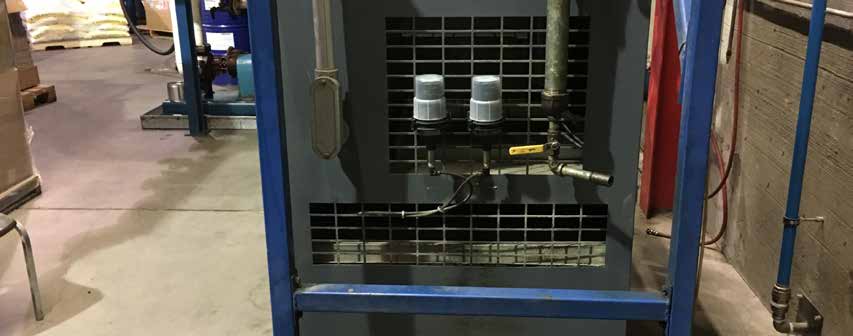Testimonials

Lubrication Engineers, Inc. enhanced their air compressor's oil change interval and maintenance efficiency through a reliability program.
key takeaways

Challenge
Darren Booth, vice president of manufacturing operations, implemented a companywide shift to treat lubricant as a valuable asset rather than a consumable, eliminating the costly and wasteful practice of annual oil changes regardless of necessity.
LE solution
LE’s lubrication reliability program, initiated in 2009, transitioned to condition-based maintenance using training, oil analysis, and contamination control, resulting in extended lubricant life and reduced unnecessary oil changes, saving significant maintenance costs.
Results
Switching to condition-based oil changes allowed LE to extend oil life to 30,000 hours, saving on lubricant costs, reducing downtime, and avoiding a $10,000 to $16,000 compressor rebuild or replacement.


Customer Profile
A leader in lubricants since 1951, Lubrication Engineers, Inc. manufactures and markets high-performance lubricants formulated from highly refined base oils and proprietary additives. These enhanced lubricants are used in a wide variety of industrial and automotive applications. LE also offers a full line of lubrication reliability products and services, including solutions for oil analysis, storage, handling and transfer, contamination exclusion, contamination removal, education and training. LE’s 200,000-square-foot manufacturing facility and technology center is located in Wichita, Kan.
Application
Like most manufacturers, LE uses an air compressor to supply compressed air throughout its facility. LE’s air compressor is an Atlas Copco model, purchased in 1997. This critical piece of equipment supplies air to keep the boilers running. It is vital to LE’s product manufacturing as well as other areas, such as packaging.
“Without air, the plant wouldn’t run,” said Brett Rausch, maintenance technician.
Challenge
The LE maintenance team was changing the oil – Multilec® Industrial Oil (6802) – every year, regardless of need. Oil analysis was done just to see if anything was breaking down; the oil was going to be dumped anyway. This was a time-consuming, expensive waste of premium oil that was designed to provide long- lasting protection.
Darren Booth, vice president of manufacturing operations, initiated a companywide change to start engaging in the same lubrication reliability best practices that LE was teaching its customers, which included treating the lubricant as an asset to be protected, instead of as a consumable.
LE Solution
In 2009, LE officially started its lubrication reliability program, transitioning from interval-based to condition-based maintenance. This meant keeping lubricants clean and dry. The goal was to extend lubricant life while continuing to protect equipment. The main components of the new program were training, oil analysis and contamination control.
First, LE sent its maintenance team to reliability conferences and put them through MLT I training. This helped the team become more knowledgeable about the equipment, the reason for the changes, and the goal of the program. They became the “owners” of the new program. Next was the Xpert™ Equipment Reliability Assessment – a lubrication survey that covered the entire plant.
One of the most important changes was using Xamine™ Oil Analysis more intentionally to find out if they could extend the oil service life. They also improved sampling procedures to ensure better results.
“Once we started doing oil analysis to see if the compressor oil was still good, we realized we didn’t need to throw it away,” Mario said. “We used to change the oil annually, just because the OEM recommended that.”
They also installed Lube-It® lubrication management software on their computers and mobile devices to keep track of their sampling and service schedule. They began using contamination control tools throughout the plant. This included the use of two Xport™ Star Vario 60cc SPLs on the compressor, each containing Monolec® Multiplex Lubricant (4622), to provide the right amount of grease – at the right intervals – to the electric motor bearing on the back of the compressor. This further protected the equipment and freed up maintenance time.
Results
The compressor OEM recommends changing the oil every 8,000 hours, which is approximately one year for LE. However, after making the switch to condition-based oil changes, the maintenance team was able to show that the oil was still in good condition well past the 8,000-hour mark. They eventually changed it at 30,000 hours, and even then the oil could have gone longer.
“The oil was still acceptable, but the slight change in viscosity was the reason we changed it,” said Mario Serrano, maintenance supervisor. “We had already gone more than three times longer than OEM recommendations.”
In addition to reducing the amount of lubricant used, the extended drains also reduced the time that the equipment needed to be shut down and the man-hours to refill oil and dispose of the old oil.
The Atlas Copco service tech recommended that most air compressors need to be rebuilt at 100,000 hours, which is approximately 12 years for a plant such as LE that runs one shift. LE has been using its air compressor for 19 years as of 2016, with no need to rebuild. Oil analysis continues to show no signs of significant wear. This is a substantial savings for the company. A rebuilt or new compressor would cost approximately $10,000 or $16,000, respectively, in addition to lost production time.


